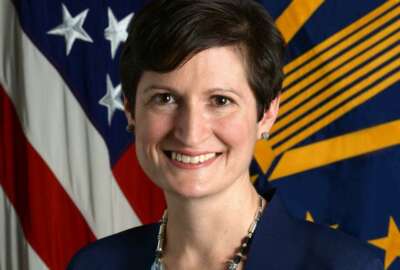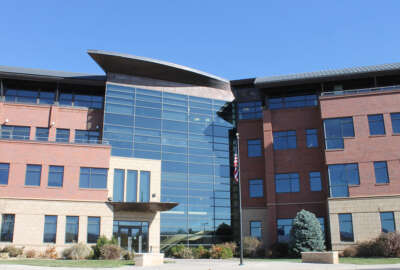
Meet the federal executive whose career has involved the great outdoors
Among last year's Presidential Rank Award recipients was a senior executive whose entire 25-year federal career has had to do with the outdoors. He started with the...
Among last year’s Presidential Rank Award recipients was a senior executive whose entire 25-year federal career has had to do with the outdoors. He started with the Fish and Wildlife Service and now he is the Nevada state director for the Bureau of Land Management. the Federal Drive with Tom Temin talks with Jon Raby.
Interview transcript:
Tom Temin Well, great state you’ve got out there, aside from Las Vegas, the rest of it’s really nice. And am I right, in saying that you have an outdoor thread that you were able to weave into a federal career?
Jon Raby I do, absolutely. I’m a graduate of Ohio Northern University. I have a biology degree. And I started out my career as a fisheries biologist, and even as a student, I volunteered for the Fish and Wildlife Service. So I actually started as a volunteer 33 years ago. I had a 33 year federal career with three different agencies, between 28 years of the Bureau Land Management, two years of the Fish Wildlife Service and three years with the U.S. Forest Service. So, I’ve worked at every level in the Bureau of Land Management from staff level, fisheries biologists, really starting at the ground level up to leadership positions in our field offices and district offices and all the way up to state director in Montana and the Dakotas, and now here as a state director in Nevada. I also spent some time in D.C., where I was the senior advisor for the Assistant Secretary of Land and Minerals Management, as well as the chief of staff for the Bureau of Land Management Director. Yeah, it’s been a great career, worked in four states California, Oregon, Montana, Nevada and in the District of Columbia. So it’s been a great career.
Tom Temin And you have been through some of the upheavals that the Bureau of Land Management had. I guess it’s probably good 10-12 years ago now, but it really did get resettled into a different kind of an agency.
Jon Raby Well, we have, as an agency when I started out, I feel like as a bureau, we’ve always been in a state of adaptation and working to change in a way that best meets the needs of the public we serve. And so that means at times we have to be adaptive. And certainly, over the years when we’ve been working to get decisions closer to the ground, we’ve had some organizational change that reflected that. And certainly, here most recently as we’re looking to make sure that we have the right leadership composition and representation of our senior executives in D.C., we certainly see that focus right now. And so really excited that we’re working to rebuild the bureau in a way that reflects the needs of the American public.
Tom Temin And as a state director, what exactly do you do? Do you review the applications for use of federal land? Or what happens there?
Jon Raby We have a lot going on, Tom, as you can imagine. So in Nevada, we have a lot of renewable energy development. We also have a lot of energy transmission projects in the queue. Mineral development, as well as our conservation efforts. And I’ll just touch on those in a little more detail. So our renewable energy development, we have everything from solar and wind and geothermal, but the vast majority of what we do is solar energy permitting. And so we have a goal right now, in Nevada, to meet the 25. We have 25 gigawatts by 2025 that the Energy Act of 2020 laid out for us nationally. And of that, we’re looking at 13 gigawatts in Nevada. And so when we look at the entire state of Nevada, it’s about 71 million acres, it’s a large state of that. The Bureau of Land Management, I’m responsible for 47 million acres. That’s about two-thirds of the state. And we’re focusing our opportunities for development on about 9 million acres. That’s just the planning area, roughly. It’s available to us, just to give you an idea of, sort of, the footprint of each solar project, about one gigawatt of power equals about 5,000 acres of solar panels. And so when we do that simple math of 13 gigawatts and, 5,000 acres per gigawatt, that’s about 65,000 acres we need a permit in the next several years, and we’re on track to do that. Of course, that all means we’ve got to have those located in the right place, and make sure that we’re sensitive to the surrounding desert and sagebrush landscapes, ecosystems. And that takes just a lot of planning.
Tom Temin We’re speaking with Jon Raby. He is Nevada state director for the Bureau of Land Management. And as an outdoorsman, what do you think about covering thousands and thousands of pristine acres with these burning, reflective things where a low rise building in one place, with a single clean smokestack, could do all of what that thousands of chewed up acres with solar panels could do?
Jon Raby Again, we’re working in conjunction with our transmission projects. And if you can imagine, well, I just mentioned we have three transmission projects that are on the White House’s list for critical transmission infrastructure. We have one that’s Greenlink West, one that’s Greenlink North and then we have our Southwest dinner type project. And you can imagine an inverted triangle that reflects those three utility power lines. Those are 500 kV lines that are going to be able to carry about four gigawatts, each, to energy markets. And a lot of the solar development, the proposals are in areas that are closely aligned with where those transmission lines are. And so we try to incentivize areas that may have previously been disturbed. We’re looking at areas that also have the least amount of resource conflicts. And so, again, that careful siting is incredibly important. And of course, as an outdoors person, it’s always in the back of my mind about ensuring that those areas also are available for people who want to hike and recreate, and do the things that they want to do on their public lands. And so we hold ourselves to high standards, and we have to ensure that we’re factoring the other users in to the authorization process as well.
Tom Temin And we did speak to you because you are a presidential rank award recipient, congratulations. And what is it specifically that got that award on your shoulders?
Jon Raby Thanks for that recognition, Tom. And there’s a lot to that over a long period of time. And I like to think, first and foremost, that I’m being recognized really because of my ability to help our employees and help our teams achieve greater things than they otherwise would think they could achieve. And we just have a great team here in Nevada. I mentioned the renewable energy projects and transmission projects. We also have a lot of critical mineral development in our teams. And what I’ve been able to help them through, with our lithium projects, that have been recently in the news and a big focus for us. And we have a couple of different projects that have been in the queue where we withstood litigation. And, at this point, we have our Thacker Pass project, which is being actually implemented right now, and that can produce up to 25% of the world’s supply, Lithium. Which we all know is so critical for electric vehicles and our renewable energy goals and that each one of those electric vehicles takes £80 of lithium and £80 of copper as well. And so our minerals are just the foundation for our technology, industrial needs, defense needs as well. So that’s been a highlight of my career and really helping our team to get to a point where we can really see the fruits of those labors.
Tom Temin And are you an electric car guy yourself?
Jon Raby Well, not yet. I mean, they’re getting better and better. And so we’re looking for the day. I’m a truck guy, so I look for the day when we can see some some 4×4 trucks that are really cutting edge in the electric vehicle side.
Tom Temin Well, they’re coming, but they’ll weigh about £7,000. That’s part of the problem with it. And now you’re not that old. You’ve been in the government 25, 26 years, you’ve got some years left. What do you hope to do in the remaining time of your career?
Jon Raby Well, in the remaining time, for me, it’s making sure we get good projects out there. I think, one of the legacies that I’m always really proud of is our conservation efforts as well. And so in Nevada, we have right now two designated national monuments, and we have a number of national conservation areas. We have Gold Butte National Monument, we have the Base and Range National Monument, we have the Red Rock National Conservation Area, we have some Sloan Canyon National Conservation area. And the President announced that the National Native American Congress here, in November, that he’ll be designating the vehicle main national monument sometime here in the near future. So looking forward to that. And as always, I got to make a plug for our Red Rock National Conservation Area. We get about 4 million visitors there, it’s about 30 minutes from the Vegas strip and it’s the place to get married now. We have over a thousand weddings a year at Red Rock, and it’s just an incredible place.
Copyright © 2025 Federal News Network. All rights reserved. This website is not intended for users located within the European Economic Area.
Tom Temin is host of the Federal Drive and has been providing insight on federal technology and management issues for more than 30 years.
Follow @tteminWFED





